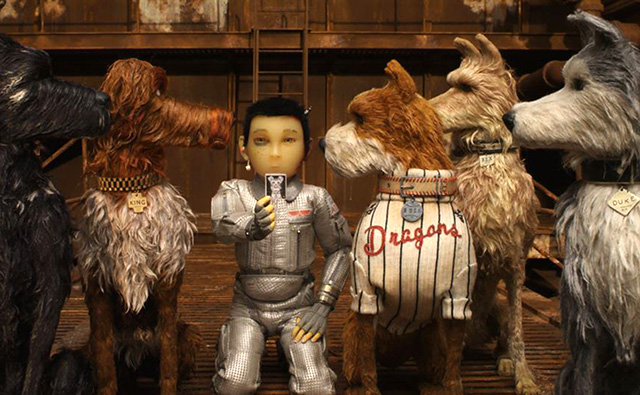Isle of Dogs Wags a Heartfelt And Serious Tale

Hollywood loves a good “boy and his dog” story. When done well, they can be full of genuine drama, gentle humor, heart-wrenching loss and heartwarming reunion.
Isle of Dogs, Wes Anderson’s new stop-motion animated film, is unequivocally one of the best.
If it were simply a straightforward story about a stalwart boy looking for his lost dog and a lost dog looking for a master, Isle of Dogs would be a standout. It’s fun and funny, engaging and endearing, beautifully filmed, crackling with incredible artistry and meticulous craftsmanship. Hiding in plain sight just behind the main story is a much darker, more complex one; a highly topical cautionary tale about the ugly appeal of xenophobia, the allure of authoritarian rulers, and how the most vulnerable members of society are treated. It incorporates both elements into a strong, cohesive, entertaining movie that begs to be seen several times.
The brilliant opening sequence — featuring a boy samurai, a shogun, and house pets drawn in the classic ukiyo-e woodblock print style — sets the stage for the conflict between the Kobayashi clan and the canine population of the near-future fictional Japanese city, Megasaki.
Mayor Kobayashi, voiced with soft menace by co-writer Konichi Nomura (Lost in Translation), leads a strident anti-dog movement bent on ridding the city of all canines. By demonizing the pooches with lurid stories of incurable diseases like snout fever, he stokes people’s fear of a runaway dog population and wins a vote to exile all canines to Trash Island. He starts with his own loyal household pet, Spots, (Liev Schreiber). It’s a hostile, awful place for any animal, but doubly so for the indoor dogs used to a warm bed and plentiful food banished there. Predictably, things go a bit Lord of the Flies, with packs of dogs fighting for nearly inedible garbage.
When a young boy from the mainland crash lands, a small pack of not-quite-feral dogs, still desperate for human companionship, investigates. Except for loner and proud stray, Chief (Bryan Cranston), the pack votes to help the boy Atari (newcomer Koyu Rankin) on an epic quest to find his lost dog. Back in Megasaki, a cabal of radical dog-loving middle-schoolers, led by American exchange student Tracy (Greta Gerwig), is working diligently to overturn the dogs’ exile while dealing with the strong-arm tactics of the mayor’s faction.
All of these threads are woven together in a wildly imaginative tapestry of stop-motion animation, ukiyo-e style drawings, and incredibly detailed sets. The experience is immersive and thrilling. The visuals are stunning, engaging, and very Wes Anderson. His love of symmetrical framing is prevalent, but he also incorporates traditional Japanese aesthetics: perfectly composed shots are intentionally made imperfect with a subtle, asymmetrical element like a single crooked tree. It’s an understated blending of eastern and western.
Anderson and co-writers Roman Coppola, Jason Schwartzman, and Kunichi Nomura create a clever pastiche that draws from numerous classics without being a slavish or cliched. They pay homage to Kurasawa, Old Yeller, Jack London’s iconic “Call of the Wild,” even Looney Tunes. The incredibly detailed miniature sets are reminiscent of the cities Godzilla stomps through in classic Japanese kaiju movies. The combination of visual styles and storytelling is at once very familiar and wildly innovative.

Production design is very similar to Anderson’s last animated film, Fantastic Mr. Fox, on a bigger, grittier scale. Dog fur ripples and sways in the breeze; cotton batting is used for all manner of smoke effects. The combination of bright colors and muted grays is particularly effective. In fact, stop-motion may be the only medium in which this film could be done well, free of the absurdity of using CGI to make dogs ‘talk.’
The voice cast is stellar. Bryan Cranston’s Chief is gruff, lonely and full of pathos. Jeff Goldblum is delightful as gossip-hound Duke. Scarlett Johansson gives disillusioned show-dog Nutmeg a raspy world-weariness. Anderson regulars like Bill Murray, Frances McDormand, and Edward Norton bring their unique talents to Isle. Harvey Keitel, Tilda Swinton, Ken Watanabe, and even Yoko Ono round out the cast perfectly.
Like the film itself, the score is a clever blend of styles. Composer Alexandre Desplat, who wrote the hauntingly beautiful score for The Shape of Water, combines traditional Japanese music, especially taiko drumming, with earnest, acoustic singer-songwriter tunes. Music is used with more subtlety than it often is in Anderson films; it’s all the more powerful and effective for it.
While writing began in 2015, the themes that suffuse Isle of Dogs — weaponized xenophobia, autocratic leaders, the victimization of vulnerable groups — resonate perfectly in 2018. Isle makes no attempts to disguise its anti-authoritarian message. It uses potent imagery, like a scene reminiscent of the classic Apple MacIntosh ‘1984’ ad, to vilify the strongman mayor. All the same, it’s delivered as the proverbial iron fist in a velvet glove. It’s occasionally overt but not preachy, and never at the expense of making a fun movie. If anything, it shows the power of humor in the face of adversity.
Whether you love or hate Isle of Dogs may depend on how you feel about Wes Anderson movies. Isle shares the art-house feel, hyper-stylized visuals, precious set design and family conflict common to Anderson films. It’s his most overtly political film. It’s also one of his best, using all of the colors on his enormous palette to tell a multi-layered story that is funny and touching, topical and compelling, brilliantly cinematic, and consistently entertaining.
Ephemera:
- Be prepared for some unconventional use of language. Dogs and official translators speak English; Japanese people speak Japanese, without subtitles. It’s a little surprising at first, but doesn’t prevent from understanding the intent or the message. It’s a clever riff on how dogs understand some human words, tone and gestures but ultimately communicate in their own unique ways. It’s also a subtle but powerful reminder that different people speak different languages, but with a little effort we can understand each other.
- While I wouldn’t think of Isle as a kids movie, all of the kids in the screening were laughing at the silly dogs and scowling at the mean old mayor. Subtext might be lost on them, but they enjoyed a fun movies about animated pooches.
Isle of Dogs (Fox Searchlight; rated PG-13): A-



